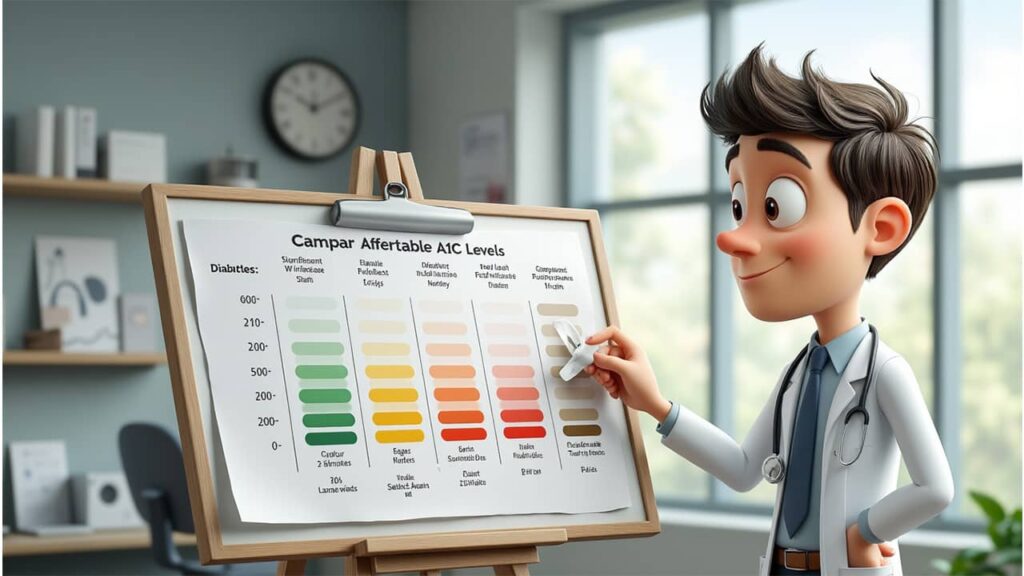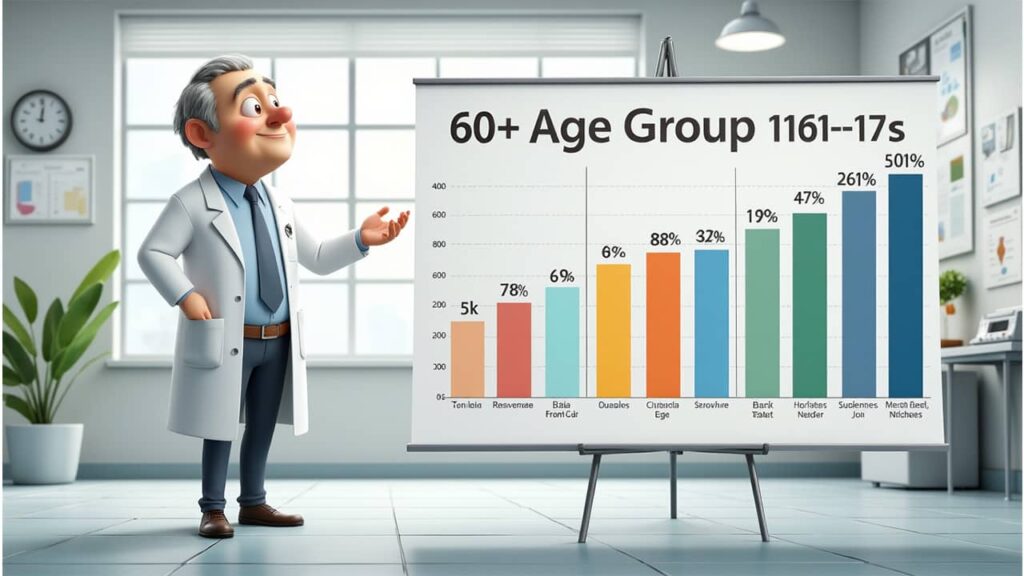Normal A1C Levels for Seniors: A Complete Guide

Knowing the normal A1C levels for seniors is essential for maintaining long-term health and preventing diabetes-related complications.
Table of Contents
For many older adults, understanding the normal A1C for seniors can help guide lifestyle choices, medical check-ups, and treatment plans.
This guide explains the target A1C ranges by age, why they matter, and how to keep your levels in a healthy range backed by expert recommendations and current research.
What Are Normal A1C Levels for Seniors?

The normal A1C levels for seniors typically fall between 7.0% and 7.5% for healthy older adults, according to the American Diabetes Association (ADA).
This slightly higher range compared to younger adults accounts for natural age-related changes and reduces the risk of hypoglycemia.
When discussing the A1C range for seniors, it’s important to consider overall health, presence of chronic conditions, and individual goals set by a healthcare provider.
For example:
- Healthy seniors with no chronic illness: <7.5%
- Seniors with mild to moderate chronic disease: <8.0%
- Seniors with multiple health complications: <8.5%
Regular monitoring and open communication with a doctor can ensure these targets are realistic and safe for each individual.
Acceptable A1C Levels for Seniors With Different Health Conditions

The acceptable A1C levels for seniors depend largely on each person’s health status, mobility, and risk factors.
Unlike a universal target, these levels are tailored to balance effective blood sugar control with the prevention of dangerous lows.
Healthy Seniors
or healthy older adults without significant medical issues, the goal is usually an A1C under 7.5%. This allows for tight control without exposing the patient to unnecessary hypoglycemia risks.
Seniors With Diabetes and No Complications
For seniors managing type 2 diabetes effectively but without major complications, the acceptable target is often below 8.0%. This range offers flexibility while still protecting against long-term damage from high blood sugar.
Seniors With Multiple Chronic Conditions
In cases where seniors face multiple chronic conditions or advanced illness, a more relaxed goal up to 8.5% may be acceptable. In these situations, quality of life and comfort are prioritized over aggressive glycemic control.
In-depth guidelines can also be found in our A1C Levels by Age Chart, which details how recommended targets shift across different life stages.
Recommended A1C Levels for Seniors by Age Group

The recommended A1C levels for seniors vary not only by individual health but also by age group. As people get older, the body’s ability to regulate blood sugar naturally changes, and so do medical priorities.
While younger adults may aim for stricter blood sugar control, older adults particularly those over 65 often benefit from slightly more flexible targets.
This approach reduces the risk of hypoglycemia, which can be particularly dangerous in seniors due to increased fall risk, heart complications, and cognitive effects.
Below is a Gutenberg-friendly table outlining suggested A1C ranges for seniors according to age and health status.
📊Normal and Recommended A1C Levels for Seniors by Age
| Age Group | Healthy Seniors | With Diabetes, No Complications | With Multiple Health Conditions |
|---|---|---|---|
| 60–69 | < 7.5% | < 8.0% | < 8.5% |
| 70–79 | < 7.5% | < 8.0% | < 8.5% |
| 80+ | < 8.0% | < 8.5% | < 9.0% |
Why Age Matters in A1C Targets
A 65-year-old with good mobility and no chronic illness might have similar targets to a younger adult, while an 82-year old with multiple conditions may have a looser goal.
These differences are not about lowering the importance of diabetes management but about balancing quality of life with safety.
Medical organizations like the American Diabetes Association (ADA) and the International Diabetes Federation (IDF) recommend individualized targets based on:
- Life expectancy
- Cognitive function
- Presence of cardiovascular disease
- Risk of severe hypoglycemia
- Support system at home
Recommended A1C for Seniors: Beyond the Numbers
While the numbers in the chart are helpful, they should not replace professional medical advice. Your doctor might adjust these ranges depending on your daily habits, medications, and how your body responds to treatment.
💡 Tip: Seniors can benefit from tracking their A1C alongside daily fasting glucose levels. This combined approach offers a more complete picture of blood sugar control over time.
To compare these ranges with other age groups, see our A1C Levels by Age Chart.
How to Maintain Healthy A1C Levels in Older Adults

Maintaining normal A1C levels for seniors requires a combination of healthy habits, regular monitoring, and a personalized approach to treatment.
While numbers are important, lifestyle choices and consistent medical care play an equally critical role in long term health.
1.- Follow a Balanced Diet
Eating a variety of whole foods, rich in fiber and low in added sugars, can help keep your A1C range for seniors within the recommended limits.
The American Diabetes Association (diabetes.org) suggests focusing on vegetables, lean proteins, healthy fats, and whole grains to maintain stable blood sugar.
2.- Stay Physically Active
Even light activity, like walking or chair yoga, can improve insulin sensitivity and help maintain recommended A1C levels for seniors.
According to the Mayo Clinic (mayoclinic.org), seniors should aim for at least 150 minutes of moderate exercise per week, adjusted to their mobility and health conditions.
3.- Monitor Blood Sugar Regularly
Checking your blood glucose at home and scheduling regular A1C tests can prevent surprises.
The National Institute on Aging (nia.nih.gov) advises seniors to discuss with their doctor how often to test, especially if medication changes occur.
4.- Manage Medications Safely
Many seniors take multiple prescriptions, which can affect blood sugar control.
Always review your medication list with your healthcare provider to avoid interactions and ensure your acceptable A1C levels for seniors remain safe and realistic.
5.- Prioritize Sleep and Stress Management
Many seniors take multiple prescriptions, which can affect blood sugar control.
Always review your medication list with your healthcare provider to avoid interactions and ensure your acceptable A1C levels for seniors remain safe and realistic.
6.- Prioritize Sleep and Stress Management
Chronic stress and poor sleep can elevate blood sugar. Techniques like meditation, deep breathing, or gentle stretching before bed can help support normal A1C for seniors.
For a full breakdown of A1C targets by age group, visit our A1C Levels by Age Chart.
Common Myths About A1C in Seniors

There are many misconceptions about normal A1C levels for seniors, and believing them can lead to unnecessary worry or poor blood sugar management. Let’s break down some of the most common myths.
Myth 1 – Lower Is Always Better
Many seniors believe that the lower their A1C, the healthier they are.
While very low numbers might seem ideal, they can increase the risk of hypoglycemia, which can be dangerous for older adults.
The American Diabetes Association (diabetes.org) advises individualized targets that balance blood sugar control with overall safety.
Myth 2 – All Seniors Should Have the Same Target
The truth is, recommended A1C levels for seniors vary depending on health status, mobility, and life expectancy.
A healthy 65-year-old might aim for under 7.5%, while an 85-year-old with multiple health issues might have a goal closer to 8.5%. This flexibility is supported by the National Institute on Aging (nia.nih.gov).
Myth 3 – If Blood Sugar is Normal, You Don’t Need to Check A1C
Even seniors with daily glucose readings in range can have elevated A1C levels over time.
That’s why regular testing is recommended it reflects average blood sugar over the past three months, giving a more complete picture than daily checks alone.
Myth 4 – Diet Alone Can Control A1C in All Seniors
While a healthy diet is critical, some seniors may still need medication to maintain acceptable A1C levels for seniors.
Age related changes in metabolism and hormone regulation mean that lifestyle changes, while powerful, may not be enough for everyone.
To understand exactly how age affects A1C targets, check our full A1C Levels by Age Chart.
When to See Your Doctor About Your A1C

Knowing when to consult a healthcare professional is just as important as understanding the normal A1C levels for seniors.
Even if you feel well, changes in your A1C could signal the need for medical adjustments or further testing.
1.- A1C Above Your Target Range
If your results are consistently higher than the recommended A1C levels for seniors, it may indicate that your current diet, exercise, or medication plan is not working effectively.
The Mayo Clinic (mayoclinic.org) recommends working with your healthcare team to adjust your plan before complications develop.
2.- Sudden Increase or Decrease in A1C
A noticeable shift away from the acceptable A1C levels for seniors even if still within the safe range can point to changes in how your body manages glucose.
This might be caused by new medications, stress, illness, or dietary changes.
3.- Symptoms of Hypoglycemia or Hyperglycemia
If you experience dizziness, confusion, excessive thirst, or unexplained fatigue, your normal A1C for seniors could be at risk of drifting outside its optimal range.
These symptoms warrant immediate testing and consultation.
4.- Annual or Semi-Annual Checkups
Even if your normal A1C levels for seniors are stable, most experts recommend testing at least twice a year or more frequently if your doctor advises.
The American Diabetes Association (diabetes.org) emphasizes that regular monitoring helps detect changes early.
Conclusion

Understanding the normal A1C levels for seniors is the key to effective diabetes management in older adults.
Whether you’re aiming for a tighter range like 7.0–7.5% or a more flexible target based on your health condition, knowing your numbers empowers you to make informed lifestyle and medical decisions.
The recommended A1C levels for seniors are not one-size-fits all. They depend on your age, general health, and risk factors.
That’s why regular checkups, open communication with your healthcare team, and following reliable sources like the American Diabetes Association are essential.
If you are unsure whether your current results fall within the acceptable A1C levels for seniors, now is the time to discuss them with your doctor.
Early adjustments to your diet, physical activity, or medication can prevent serious complications and help you maintain your independence and quality of life.
💡 Final tip: Keep this guide bookmarked and refer back to the normal A1C levels for seniors chart whenever you get new test results.
Comparing your numbers with recommended ranges will help you track your progress over time.





